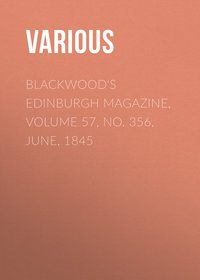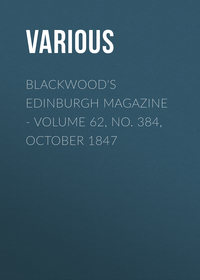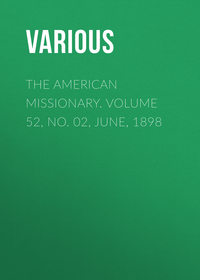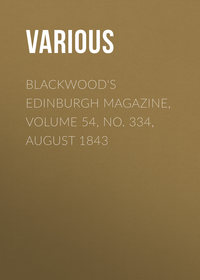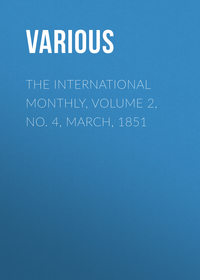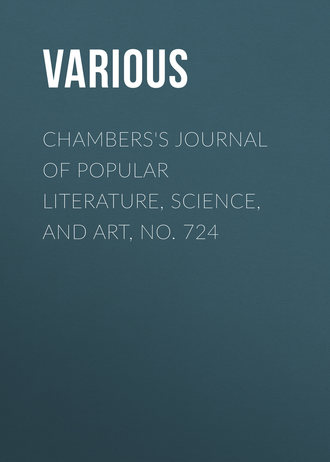 полная версия
полная версияChambers's Journal of Popular Literature, Science, and Art, No. 724
THE GERM THEORY AGAIN
We have on several occasions alluded to the Germ theory, by which is meant the theory that invisible germs, capable of producing animalculæ and of spreading disease are constantly floating in the atmosphere – and that the more impure the air the greater are the number of these germs. We revert to the subject, because it is debated in all quarters, and it is as well that our readers should know something of what is causing so much controversy. Some surgeons distinguished as operators are great believers in the Germ theory; so much so, that before beginning, for instance, to cut off a leg, they cause a certain germ-killing liquid to shower like spray near the part operated on; by which, as is alleged, the wound is kept free of anything noxious. Whether there be germs or not, the use of disinfectants in the air is said to be beneficial. Notably the celebrated carbolic-acid plan of Professor Lister has met with marked success, and is practised by the greatest surgeons of our time. But though the air certainly contains something which favours decomposition, it is by no means yet proved that that something is made up of germs.
Professor Tyndall has been the principal advocate of the Germ theory, and has written some papers strongly in its favour. Professor Bastian takes an opposite opinion. He thinks that living organisms may originate in disease by spontaneous generation. His notions are that if germs are continually floating about in the air, they would drop everywhere and anywhere alike. This argument applies more forcibly to the fact which Dr Bastian discovered – namely, that he was able to get life in flasks containing inorganic solutions, but that he always failed if such solutions were not made up of salts containing oxygen, hydrogen, carbon, and nitrogen; that is to say, of the elements of life. If the organisms are really the result of a molecular arrangement of the 'mother-liquid,' we should expect to find them only in those fluids which already contain the elements necessary for their composition. Three speculations are involved in these experiments: on the one hand, that low forms of life do occasionally arise by spontaneous generation; on the other hand, either that the heat which is usually considered destructive of life and germinating power is in reality nothing of the kind; or that Dr Bastian's experiments were incorrectly performed.
Since the publication of Dr Bastian's observations, a very lively controversy has been carried on in scientific quarters between the supporters of the germ theory and of the theory of spontaneous generation. Dr Bastian's work was conducted with great care and in the presence of some distinguished authorities. Dr Sanderson, on the other hand, found that upon increasing the heat which is applied to the flasks, no organisms were produced; but until we have reason to doubt the generally received opinion as to the amount of heat necessary to destroy life, this result may be equally well explained according to either of the two theories.
Dr Bastian insists that the organic solutions in his own flasks are not found by him to undergo putrefaction where every precaution is taken for withholding the entrance of air. Thus a simple piece of cotton-wool, which acts as a kind of sieve, will when placed in the mouth of a flask prevent decomposition. Professor Tyndall has invented the most ingenious contrivances for illustrating his views. In one case he employed a chamber the walls of which were covered by a sticky substance. The particles of dust in the air were allowed to collect and adhere to the sides, and the air in the vessel, as shewn by its non-reflection of a beam of light, was rendered comparatively dustless. Flasks were now introduced, and they remained for a long period free from organisms. On repeating some of these experiments this year, however, Professor Tyndall found that many of the infusions which had previously been preserved from putrefaction with ease, were now found, when placed under the same conditions, to swarm with life. Still he refused to believe in 'spontaneous generation,' and preferred to consider that the production of life in his flasks was due to some fault in his experiments, and that the air of the Royal Institution was not so pure this year as it was last. Instead, therefore, of introducing his fluids by means of an open pipette, as he had previously done, he now made use of a 'separating funnel,' and by this means the fluids found their way into the flasks without exposure to the air. The result of these precautions was that no organisms appeared. The objection, however, that we have to find is, that no guarantee can be given that will enable us to ascertain whether the air is really free from particles of organic matter or not. Last year the air was considered to be pure because moteless; but this year, though moteless, it was found to be impure.
Professor Tyndall and his friends are so exceedingly confident in the power of the germs of the atmosphere, that they attribute to their influence every known case of putrefaction; and they do so because they believe that they have proved that whenever the air can be excluded from a putrescible fluid, putrefaction will not take place. But Dr Bastian has succeeded in producing life out of organic infusions from which the air has been excluded, and which have been previously raised by him to temperatures hitherto considered by scientific authority as fatal to life. Thus the question resolves itself into this: What is the exact point of heat which kills the germs of bacteria? At present we do not know, and we have therefore no right to make any supposition upon this point in favour of either of the two theories.
Since Dr Bastian's experiments were first made public, the holders of the Germ theory have gradually raised what we may call the thermal death-point of bacteria, in order to explain away the results of his experiments by the light of their own theory. If Dr Bastian's fluids did develop life, they say, the germs must have entered into them by some means or other; and if he superheated these fluids, the fact of the germs surviving the process shews that they must be possessed of greater enduring power than we have given them credit for.
Curiously enough, Professor Tyndall declares that frequent applications of a low degree of heat, and applied at intervals, have a far greater 'sterilising effect' than a single application of a high temperature. For a given fluid may contain germs of all ages. If such a fluid be boiled for a considerable time, all the germs of recent formation will be killed; but those of a greater age will merely be softened, but still capable of reanimation. If, however, the fluid be heated for a short time only, the recent germs will be destroyed, while an older crop will be liberated. A second application of heat destroys this second crop, and brings a third into play. Further heat will awaken successive crops, until at length a point is reached when the toughest germ must yield. This is certainly a most ingenious explanation of the difficulty.
A very interesting contribution to this subject has lately been made by Dr Bastian and others; and we will now briefly describe the main results of their researches. It has long been known that slightly alkaline organic fluids are more difficult to sterilise than those which are slightly acid. Pasteur the French chemist says that animal water in its normally acid state becomes sterile at one hundred degrees centigrade; but that if the infusion is first rendered alkaline by the addition of potash, the application of a little more heat is necessary, in order to insure sterility. If we bear in mind the two theories, we shall see that these observations of Pasteur may be explained according to either of them. We may believe that the germs in the infusion are fortified against the destructive action of heat by liquor potassæ; or on the other hand, we may hold that the spontaneous generation of organisms is favoured by the presence of an alkali. Acting upon these data, Dr Bastian heated a similar fluid in its acid condition to the temperature of one hundred degrees; so that, according to Pasteur, it was now barren. He then added a quantity of potash sufficient to neutralise the acid, the addition of the alkali thus being made after instead of before the boiling; and he then allowed the fluid so treated to stand at a temperature of about one hundred and fifteen degrees Fahrenheit. In a short time swarms of bacteria appeared.
Dr Roberts, however, considers that this result was obtained because sufficient precaution had not been taken by Dr Bastian to prevent the entry of germs, which might have been introduced by the potash. Accordingly, he filled a small flask with an ounce of the acid infusion, and then sealed up his potash in a capillary tube. The potash was then heated in oil to two hundred and eighty degrees Fahrenheit, and kept for fifteen minutes. The tube of potash was now introduced into the flask containing the infusion, and the flask was boiled for five minutes, and sealed. The flask was now kept for some time in order to test its sterility. When this was ascertained, the flask was shaken, so that the little tube of potash inside was broken, and the potash was thus allowed to mingle with and neutralise the infusion. The flask was now maintained at a low temperature of one hundred and fifteen degrees Fahrenheit, and it remained perfectly clear. And so Dr Roberts concludes that liquor potassæ has no power to excite the generation of organisms in a sterilised infusion. Professor Tyndall repeated these experiments with additional precautions, and obtained similar results.
The general conclusion which is drawn from various experiments by the advocates of the Germ theory is, that liquor potassæ has no inherent power to stimulate the production of bacteria, and that any apparent power of this kind which it may seem to possess is due to the presence of germs within it. These germs they consider are not destroyed until the potash has been raised to the temperature of one hundred degrees centigrade if solid, and to one hundred and ten degrees centigrade if liquid. Dr Bastian, who repeated his former experiments with every possible precaution, found no difference in his results. Moreover, he discovered that liquor potassæ, when added in proper quantities, is just as efficacious in stimulating the development of life after it has been heated to one hundred and ten degrees centigrade, as when it has been heated to only one hundred degrees. Pasteur will consequently have to raise the temperature which he considers sufficient to destroy the germs contained in a solution of strong liquor potassæ to a point still higher than one hundred and ten degrees.
But there is still another proof that liquor potassæ if previously heated to one hundred degrees does not induce fermentation in virtue of its germs, because if only one or two drops be added, the infusion will remain as barren as ever; while a few more drops will immediately start the process of fermentation. Now if the potash really induced fermentation because it brought germs along with it, two drops would be quite as efficacious as any other amount. Finally, Dr Bastian has shewn us that an excess of alkali prevents fermentation, and to this fact he attributes the failure of Pasteur to develop life when he employed solid potash. He had added too much of the alkali.
It is impossible to draw any definite conclusion from these as from the other experiments, until we know the precise temperature which is fatal to germinal life. Dr Bastian indeed thinks that he has been able to shew that bacteria and their germs cannot exist at higher temperatures than one hundred and forty degrees Fahrenheit; but his evidence here is not quite conclusive. He does not deny the existence of germs nor their probable influence in producing life; he merely says that his experiments furnish evidence to shew that in some cases organisms may spring into existence without the aid of a parent. The strong points of his case are, that as fast as his adversaries can suggest precautions to insure the destruction of germs, he has been able to shew life under the altered conditions; and that whenever the supposed death-point of bacteria has been raised on account of his experiments, he has succeeded in obtaining life after having submitted his flasks to the required temperatures. How this most interesting controversy will end, we cannot foretell; but we hope that the further researches of our scientific men upon the subject will ultimately lead to the discovery of the truth. Meanwhile, we observe that Dr Richardson, at the late Sanitary Congress at Leamington, entirely dissented from the theory of germs being the origin of disease, and characterised it as the wildest and most distant from the phenomena to be explained, ever conceived. As no one contests the fact that pure air is a very important factor in promoting health and averting the insidious approaches of disease, people keeping that in mind need not practically give themselves much concern about germs. See that you draw pure air into the lungs. That is an advice to which no theorist can take exception.
OCEAN-VOYAGES IN SMALL BOATS
It is perhaps not generally known that adventurous persons occasionally cross the Atlantic from the American coast to England in small boats. The undertaking is dangerous, but is accomplished. Twenty-four years ago, when on board a Cunard steamer, our vessel passed an open sailing-boat containing two men on a voyage from America to Europe. They had no means for taking an observation, but trusted to fall in with large ships, from which they would get information as to where they were. On sighting them, our captain knew what they wanted, and hung out a black board on which were inscribed in chalk the latitude and longitude. This was satisfactory, and on they went on their perilous expedition. What came of them we know not. We were told that men who run risks of this kind, and who happen not to procure information as to their whereabouts, are apt to make strange mistakes in their voyage to England; such, for instance, as running on the coast of Spain instead of the British Islands – the whole thing a curious instance of reckless daring.
Small vessels, possibly better provided, have made runs which have attracted the admiring attention of nautical men, for the exceptional circumstances under which they occurred, but without reference to competition or bonus. In 1859 three Cornish fishermen, in a fishing-boat of small tonnage, sailed from Newlyn near Penzance to the Cape of Good Hope, and thence across the Indian Ocean to Melbourne, where they arrived 'all well.' We do not find the actual tonnage named. In 1866 a small yacht of twenty-five tons, hailing from Dublin, set out from Liverpool, and safely reached New South Wales after a run of a hundred and thirty days. The distance was set down at sixteen thousand miles. It was regarded, and justly regarded, as a bold adventure in 1874, when a schooner of only fifty-four tons safely brought over a cargo of deals from St Johns, New Brunswick, to Dublin, with but seven hands to manage the craft. Boat-voyages, however, are evidently more remarkable than those of clippers, yachts, and schooners; on account of the extremely small dimensions of the craft which have ventured to brave the perils of the ocean, and of the paucity of hands to manage the sails and helm during a period measured by months – under privations of various kinds.
Eleven years ago the Americans gave an indication of spirit and pluck in the conception and fulfilment of a very bold enterprise. Mr Hudson, the owner of a small craft named the Red White and Blue, fitted it up for an ocean-trip to England. It was a life-boat, built of galvanised iron, only twenty-six feet in length, six feet in breadth of beam, and three feet deep from deck to hold. Small as it was, the Red White and Blue carried what sailors call a very cloud of canvas; it had mainsail, spritsails, staysails, courses, topsails, royals, top-gallants, sternsails, trysails, three masts, bowsprit, booms, yards, gaffs, jib-boom, yard-tops, cross jack yards, spankers, and all the rest of it – an enormous amount of furniture, one would think, for so small a house. The boat was sharp at both ends, had water-tight compartments lengthwise and transverse, and safety-valves which would enable her to right herself in a few minutes if flooded. There was a tiny cockpit for the steersman near the mizzen-mast, in which he sat somewhat in the same position as Mr Macgregor in his Rob Roy canoe. The air-cylinders at each end of the boat and along the sides, customary in life-boats, assisted in maintaining the buoyancy and upright position. It is amusing to read of a mainmast only seven feet high and a bowsprit of two feet in length; but the juvenile ship was proportionate in all these matters, and bravely she looked, a plucky handsome little craft.
The crew of the Red White and Blue was as exceptional as the boat itself. The owner, Captain John M. Hudson, took the command; Mr Frank E. Fitch acted as mate; while in lieu of petty officers, able seamen, and ordinary seamen was a dog named 'Fanny.' On the 9th of July 1866 the pigmy ship took farewell of Sandy Hook, near New York, on a voyage of unknown duration and uncertain vicissitude. At midnight on the 18th the boat struck against something hard and solid, but fortunately without receiving much damage. They sailed on till the 5th of August, when they fell in with the brig Princess Royal, hailing from Yarmouth, and obtained a bottle of rum, two newspapers (very precious to the wayfarers), and a signal-lamp. Narrowly escaping a complete overturn on the 8th, they spoke with the barque Welle Merryman, from which they obtained two bottles of brandy. After another peril of capsizing, they at length sighted English land, the Bill of Portland, on the 14th. Beating up the Channel, the boat entered Margate Harbour on the 16th, after being thirty-seven days at sea. The little craft created no small astonishment at Margate. As there was no chronometer on board, the calculations of distance, direction, &c. had to be made by compass, line, and dead-reckoning. So little opportunity had there been of obtaining a fire, that the food (mostly preserved in air-tight tins) had to be eaten cold. The original store of a hundred and twenty gallons of water supplied their wants with this essential requisite. Poor Fanny the dog did not at all relish the voyage; constant exposure to the weather so weakened her that she died soon after reaching Margate. When the Red White and Blue was afterwards exhibited at the Crystal Palace, a little incredulity was expressed as to the reality of the voyage; but as the names of the vessels spoken with were given and the dates of meeting, there seems no reason to doubt the faithfulness of the narrative. The two navigators, however, did not return to America in the same way; they had 'had enough of it.'
A still bolder achievement, in so far as the number of the crew was concerned, was that of Alfred Johnson, who in June 1876 started from America in a small boat manned only by himself. Quitting the port of Gloucester, Massachusetts, on the 15th, he had fine weather for a time, but then experienced some of the peril of Atlantic voyaging under exceptional circumstances. Fogs and head winds compelled him to put into Shake Harbour, where he had his compass corrected. Starting again on the 25th, he experienced tolerably fair weather until the 7th of July, when a heavy gale set in from the south-west. The combings of the hatchway were started, and the water, finding entrance, damaged some of his provisions. The gale subsiding, he was favoured with fine weather and fair wind until the 16th; and a strong breeze in the right direction coming on, he made good progress till the 2d of August. When about three hundred miles from the Irish coast, the wind increased to a hurricane; he hove to, but in unshipping his mast for this purpose, the boat got broadside on a large wave and was upset. Johnson clambered on the upturned bottom, where he remained for about twenty minutes. By dexterous management he succeeded in righting the boat, got in, and pumped it dry; everything, however, was wetted by the upset, and he lost his square-sail and kerosene lamp.
Wending his way as winds permitted, he reached within a hundred miles of the Irish coast by the 7th, spoke a ship, and obtained some bread and fresh water – both of which had become very scanty with him. On the following day he got soundings, but fog prevented him from seeing land. On the 10th he sighted Milford, near the south-west extremity of Wales. He landed at Abercastle in Pembrokeshire on the 11th, after being fifty-seven days at sea; starting again, he put into Holyhead, and finally arrived at Liverpool on the 21st. The little Centennial, which measured only twenty feet in length over all, had run about seventy miles a day on an average. Johnson maintained his general health excellently well, though suffering from want of sleep.
The little boat that has recently crossed the Atlantic differed from Johnson's in this among other particulars, that it had a crew of two persons, one of whom was a woman. Certainly this woman will have something to talk about for the rest of her life: seeing that we may safely assign to her a position such as her sex has never before occupied – that of having managed half the navigation of a little ocean-craft for some three thousand miles. The New Bedford, so designated after the town of the same name in Massachusetts (the state from which Johnson also hailed), is only twenty feet long, with a burden of a little over a ton and a half; built of cedar, and rigged as (in sailor-phrase) a 'leg-of-mutton schooner;' with two masts and one anchor. Anything less ocean-like we can hardly conceive. Captain Thomas Crapo, the owner of this little affair, is an active man in the prime of life; and his better-half proves herself worthy to be the helpmate of such a man. On the 28th of May in the present year, Captain and Mrs Crapo embarked in their tiny ocean-boat, provided with such provisions and stores as they could stow away under the deck. The steersman (or steerswoman) sat in a sunken recess near the stern, with head and bust above the level of the deck; the other took any standing-place that he could get for managing the sails, rope, anchor, &c. The boat had no chronometer; and the progress had to be measured as best it could by dead-reckoning.
The boat, soon after leaving New Bedford, was forced by stress of weather to seek a few days' shelter at Chatham, a small port in the same state. Hoisting sail again on the 2d of June, the boat set off with a fair wind; and all went well for three days. An adverse wind then sprang up, a fog overspread the sky, and for ten days the voyage continued under these unfavourable circumstances. Whilst near the shoal known as the Great Banks, a keg was seen floating; this was secured, and the iron hoops utilised (with the aid of canvas) in making a drogue – one which was included among the outfit of the boat being found too light for its purpose. The boat, after lying to for three or four days in a gale of wind, started again, and sailed on till the 21st of June, when another gale necessitated another stoppage. The New Bedford sighted the steamer Batavia, which offered to take the lonely pair of navigators on board: an offer kindly appreciated, but courteously declined. After this meeting, a succession of gales was encountered, and the rudder broke; a spare oar was made to act as a substitute. The sea ran so very high that even when lying down to rest, husband and wife had to lie on wet clothes, everything on board being sloppy and half saturated. At one portion of this trying period Captain Crapo had to steer for seventy hours uninterruptedly, his wife being incapacitated from rendering the aid which was her wont; and on another occasion he had to pay eighteen hours' close attention to the drogue. The voyage terminated on the 21st of July, after a duration of fifty-four days. The average sleep of the captain did not exceed four hours a day; and he had no sleep at all during the last seventy hours of the run. He had intended to make Falmouth his port of arrival, but was glad to make for Penzance instead.
The surname of Crapo, we were informed by the captain, is not uncommon at New Bedford. The good wife is Swedish by descent, Scotch by birth, American by marriage – a citizen of the world. In examining the boat closely (which we have done), it becomes more than ever a marvel how it could have formed the home of a married couple for seven weeks. Descending through a small hatchway, the feet rest on the floor of (let us say) the state-cabin, an apartment three feet high; consequently the head and body project above the hatchway. By spreading blankets and rugs, and crouching down by degrees, a would-be sleeper can lie down under the deck, or two sleepers close to the two sides of the boat. The wife of course acted as stewardess, cook, parlour-maid, scullery-maid, &c., leaving her husband to manage most of the navigation. The sperm-oil lamp for the compass-binnacle; the kerosene or petroleum lamp for the cooking-stove; the receptacles for biscuit and preserved meats and vegetables; the butler's pantry for a few bottles of spirits; the vessels for containing water – all were packed into a marvellously small space. The drogue (already mentioned) is a kind of floating anchor which, dragged after the vessel by means of a long rope, helps to steady it in certain states of the wind. Five hundred pounds weight of stores and six hundred of iron ballast, kept the boat sufficiently low in the water.




